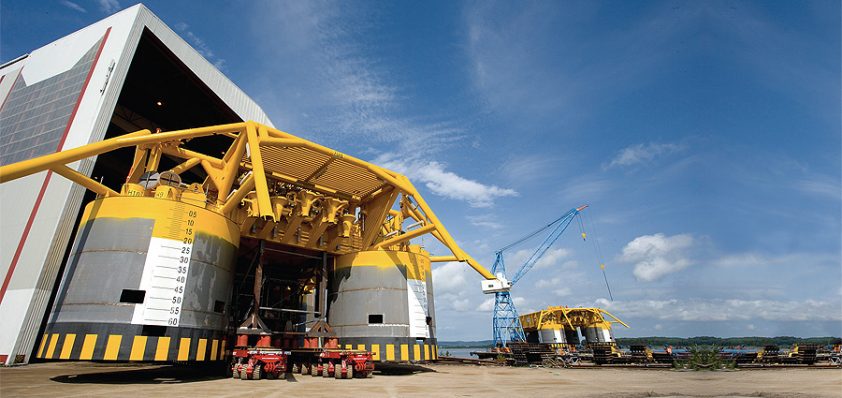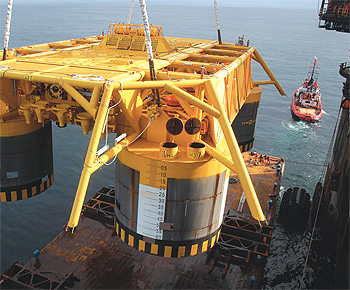
Norsk Hydro
Thinking big
Norsk Hydro has the enormous task of developing one of the largest and most challenging offshore developments in the world.
The company is committed to solving the world’s energy needs, as it believes energy is too precious a resource to take lightly. In October 2007, gas from Norway will be helping to keep ten million Britons as warm as toast. That’s when the giant Ormen Lange gas field in the Norwegian Sea comes on tap. It could cover approximately 20 per cent of the UK’s gas requirements for up to 30 years. Norsk Hydro discovered the Ormen Lange gas field in 1997, and is now busy building the subsea wells, pipelines and onshore processing plant for the project. Ormen Lange will contribute to a doubling of Hydro’s gas exports by the year 2010 – making Norway the world’s third largest gas exporter.
Thomas Bernt, head of offshore operations for the Ormen Lange project elaborates: “Due to the sheer size of the project, it was decided by the authorities that the operation of the field would be  split – Hydro is responsible for the development phase with Shell taking over the field’s operation when it comes on-stream. Back in 1997, we underwent a significant amount of research to determine how the field should be developed. We decided to implement a development solution whereby gas will be taken from the field to an onshore plant for processing and compression to take place, and then it will be transported from that plant to the UK. This was the best economical solution available to us for the project.”
split – Hydro is responsible for the development phase with Shell taking over the field’s operation when it comes on-stream. Back in 1997, we underwent a significant amount of research to determine how the field should be developed. We decided to implement a development solution whereby gas will be taken from the field to an onshore plant for processing and compression to take place, and then it will be transported from that plant to the UK. This was the best economical solution available to us for the project.”
The world’s longest undersea pipeline, Langeled, will transport the gas 1200 kilometres from Norway to England via the Sleipner distribution platform in the North Sea. At a depth of approximately 850 metres, the site is so deep that the 24 subsea wellheads and 120 kilometre pipelines to shore will have to be built using underwater robot technology and advanced installation techniques. There have been more than 20,000 people employed in the building of the processing plant, subsea system, pipelines and UK terminal.
The construction of the Ormen Lange gas field is one of the most advanced projects in history. The gas pipelines go through extremely uneven terrain and very deep waters, therefore, Hydro has faced many challenges along the way. Thomas explains: “There are many major external factors that have presented a problem to us, including the freezing conditions of the Norwegian sea and the distance the gas has to travel to shore. In order for us to overcome these we have invested a lot of time and money into the development of technology.”
Hydro’s belief in innovation and environmentally friendly utilisation of natural resources means that it is committed to solving the technical challenges in the best possible ways. He continues: “At the beginning of the project we analysed all areas of the field to see where we didn’t have the right technology for the job. The main task we had to do was to adapt current technology to work on the project. As the Ormen Lange field is so unique a significant amount of technology had to be developed in order for the project to go ahead.”
the project. As the Ormen Lange field is so unique a significant amount of technology had to be developed in order for the project to go ahead.”
The main problem Hydro faced was the positioning of the gas pipelines between the Ormen Lange field and the onshore plant. Thomas comments: “Due to the conditions of the seabed we had to develop tools, which prepared the ground for pipe laying.” Hydro, working closely with Nexans, an expert in cables and cabling systems, to develop the ‘Spider’ – a new type of digging machine to ensure that the pipelines have a more even surface to rest on. This is just one example of the numerous technological developments that have taken place during the project.
He continues: “We also performed a combination of removing peaks, routing the pipeline and installing rock on the seabed. We have placed approximately four million tons of rock altogether on the seabed and have had two vessels working on this for three years. We also had to develop technology to ensure that the gas flows through the pipeline continually without any disruptions, which may include, freezing, corrosion and blockages of gas.”
The Ormen Lange project is more than 90 per cent complete, with the southern part of the Langeled pipeline already in operation. With the end in sight, Hydro believes the Ormen Lange project has helped enhance its market presence. Thomas concludes: “This project has been a flagship scheme for Hydro and has so far been a major success. This is a result of our dedicated planning and hard work, not only by Hydro but also from every other company and stakeholders that have been involved. This project has given us a lot of coverage across the world because of its size and unique qualities. The experience we have gained throughout the successful execution of the Ormen Lange development will put us in a strong position for the future ahead.”
Norsk Hydro
www.hydro.com